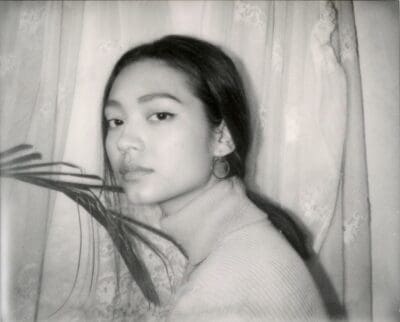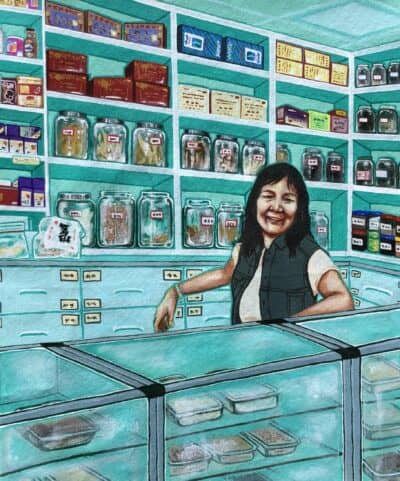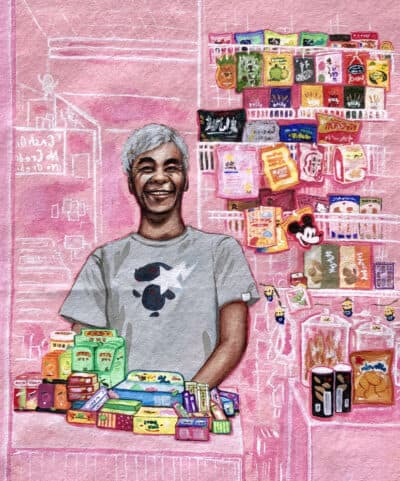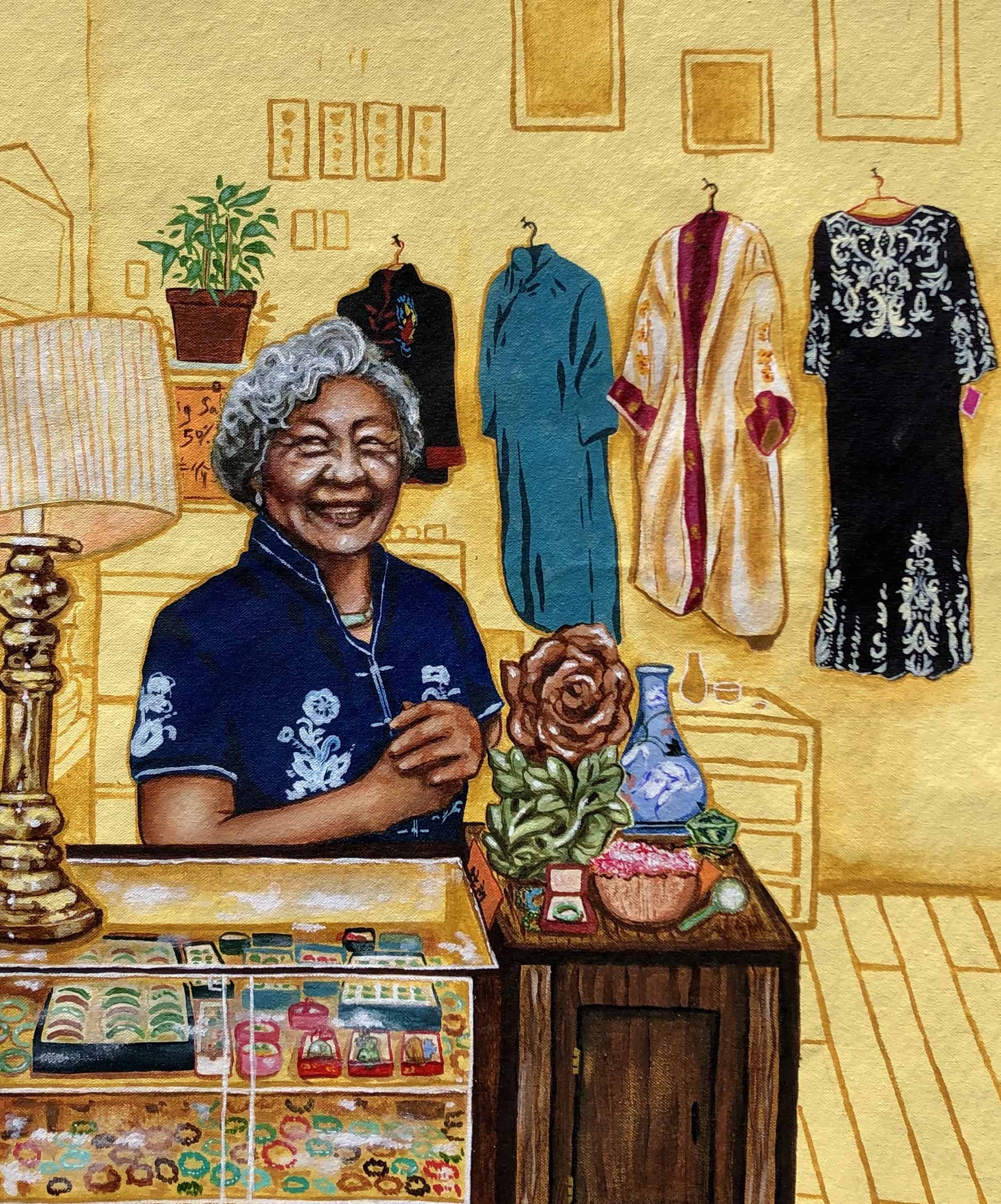OCAD’s annual GradEx show includes work by over 500 artists and is a must-see for any art lover. Buy stuff for your home, or hire a recent grad for your next creative project.
This year, more than others, we’ve noticed that there is a sizeable collection of art that sparks ideas and conversation about heritage, be it artists exploring and expressing their identity and sense of self through their art and/or using it to draw attention to racism and cultural stereotypes.
For Asian Heritage Month we wanted to spotlight daring artists who are drawing inspiration from their Asian culture, and exploring their relationship to it, and how it connects with other major societal themes.
We love the paintings that Christie Carriere did that capture shopkeepers in Toronto’s Chinatown Centre mall. “I’ve chosen to highlight some lovely people in the community around me, capturing casual moments in a playful and colourful format,” writes Christie, in her artist statement. “Engaging with these moments and these individuals feels to me like an act of care and a way to document the energy of a complex ecosystem within a neighbourhood that may soon look very different.”
Curious to learn more, we connected with Christie.

What inspired you to create this work?
I started this work in 2019 as part of my thesis at OCAD U. I think the whole series is really reflective of where I was at the time, my experience first coming into a community in Chinatown. Creating artwork around cultural heritage and identity can be tricky (bordering on existential crisis). Working out of the context of an institution, I think I was really starting to grapple with the question of who my art was actually for. Who am I speaking to? And after spending so much of my time in a community space in the basement of a mall in Chinatown, I really just wanted to make art for the people around me.
The original idea was to have a little show in this community space and invite the featured shopkeepers. The show actually did happen through a socially distanced, scheduled-visit method, but the individuals featured didn’t get a chance to see it. Though I did send a photo to one of them via WhatsApp which was nice. I think I was mostly inspired by this idea of creating, sharing, and keeping art within the context of the community it was created from. Sometimes it feels like art and ideas are just cherry-picked out of our communities, to then be examined separately within the sterile environment of a gallery. How do we make art which also benefits the communities that inspire us? I’m still figuring out how to do this.
Have you been thinking about your heritage differently this year than in the past? If so, how?
I believe a person’s relationship to their heritage is constantly shifting and evolving. Within this last pandemic year, I’ve had a lot of time to reflect more internally about my own understanding of what heritage is, what it means, and how I relate to it. Being mixed-race and having been born / raised in Canada, I’ve realized the only time I ever really experienced my heritage growing up was with family. Mostly my grandparents. Like many children, I went from seeing them every day, then less and less as I got older, then not being able to see them at all this past year. I realized that I’ve come to associate a lot of my “Asian-ness” with nostalgia, and the warm, safe feeling I had as a young child at my grandma’s house. I think maybe this is why images of familiar candy brands, or specific patterned fabrics, or domestic tasks like folding dumplings can illicit such deep emotional attachments.
Sometimes I worry that this causes me to overly romanticize my heritage. But I’m learning that sharing heritage means more than just relating over these familiar things. Along with the food and the history and the holidays, we inherit responsibility. A responsibility to care for your community, to show up for your community, to do that un-glamorous labour, as well as to have those hard conversations and address internal issues.

Medicine Shop, Chinatown Mall Project, by Christie Carriere
What part of your heritage are you most proud of / enjoy celebrating?
I’m not sure if I’m necessarily proud of my heritage, I definitely did go through a period of pride in reaction to the “shame of being different” that I was taught to feel growing up in Canada. Which is something I think a lot of second-gen and diaspora kids can relate to. Pride being opposite to shame felt logical, but then I came to a point where I grew weary of feeling like I had to wave my heritage over my head and declare my pride as the only way to justify it’s value.
I think many racialized artists are feeling that pressure of being put into the “heritage box,” being asked to only ever make work about culture and racial injustices for a White audience, being asked by the institutions to show up for moments of visibility and diversity (that never go any further) and then never engaged with again. And that feeling is central my thesis and why I made this painting.
I found a more intimate connection to my heritage when I stopped thinking about how I represented it to others and just focused on my own connections. Now I believe I’ve moved more towards place of self-recognition, there’s no pride or shame, it’s just part of who I am.
What part of your heritage do you think is misunderstood? Or do you wish people knew more about?
There are so many misconceptions and racial stereotypes, I don’t want to go on listing anything, but I think it’s important for people to understand that they don’t just come out of nowhere. If you look into the historical context of any racial stereotype there is always some sort of political / economic reason that a certain rhetoric was purposefully spread. A lot of the time they base it on the results of racist government legislation, they create the context then drastically misrepresent the cause, making it seem true.
Another common misunderstanding is how we understand the value of heritage. If you look at our communities, our neighbourhoods, protection from bulldozing is only ever given under heritage status when we have impressive and old buildings. But the value of heritage really has nothing to do with buildings. It’s a deep misunderstanding to believe there is little value in having neighbourhoods where people can provide and access their cultural foods/products/services, or speak to local elders in their languages, or just gather and share and celebrate together. People think these neighbourhoods, like Chinatown, are dying. This is not true, and this rhetoric is intentionally spread in order to flatten us with luxury condos and Supermarkets. I speak of Chinatown because that is the context of my artwork and my own heritage, but the same thing is happening to racialized neighbourhoods throughout the city, Kensington Market, Little Jamaica, to name a few.
What is the greatest lesson you’ve learned while at OCAD U?
The greatest lesson I learned throughout my experience at OCAD U was probably when I realized that they were never going to teach me how to be an artist. And this is probably true of any art school.
Coming straight from high school I think I was expecting it to work in the same way, studying hard and focusing all my attention on school would equal success. Not to say that I didn’t have amazing peers and professors, I was able to learn a lot through my relationships to them, but I think trying to squeeze the practice of art-making into the limiting structure of an institution ultimately just doesn’t work.
In the year since completing my thesis I stopped painting for a long time, I’ve heard this called “art school hangover.” I found myself needing time to slowly peel away the restricting formula I’d internalized over the past 4 years and just try to relearn how to connect to my art.
To rephrase this as a piece of advice for anyone looking to go to art school: you have to see it as a resource and make it work around you. Instead of striving to meet your assignments perfectly, take the assignments and make them fit around the art you’re already making. But you’re not going to figure out who you are as an artist by spending all your time in an institution.

Candy Shop, Chinatown Mall Project by Christie Carriere
What do you love most about the GradEx show?
I think GradEx has always been a really great way for students to come together and celebrate the fruits of their labour, I think after a year of sharing a studio and working so closely a sort of micro-community evolves and it’s these types of relationships that become key to your career as an artist. Unfortunately, these past two years we’ve had to miss out on that.
I really hope that people do still take the time to check out online GradEx, and that students will still be able to access some of the professional opportunities that usually come out of this final showcase. But I do know a lot of students just weren’t able to participate in this format. With the studios closing so abruptly, thesis work was locked up and left unfinished. And not everyone has the space/equipment to work or obtain quality documentation at home. But I’m still hopeful that OCAD U will come up with a way to retroactively provide a GradEx for those who had to miss out.
What conversations or ideas do you hope this works inspires?
I really just want someone who sees my work through GradEx to go do some shopping in Chinatown. The shop in this painting is actually closed now, but the rest of the paintings feature shop owners in the Chinatown Centre mall, a candy store, a medicinal herb shop. You can find pretty much anything you need in Chinatown and a lot of spots offer pick-up and delivery, you don’t need to be Asian to appreciate affordable groceries. And don’t just stop at Chinatown, invest a little time and love into our local neighbourhoods, which thrive despite living under constant threat of gentrification and displacement.
See more of Christie’s work on her website and follow her on Instagram. Check out all the incredible art at OCAD’s GradEx 106 virtual event now.



 Follow Us On Instagram
Follow Us On Instagram
